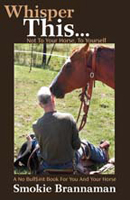By Caroline Putus
Confidence is a funny thing. I’ve been helping riders to regain and maintain their life and riding confidence for over 10 years now, and I know how it is. One minute you’re on top of the world, feeling great, and then – BANG! – something happens and all those good feelings and positive thoughts suddenly drain away. How can that be? How can you feel great one minute and then, because of something that happened, maybe bad news or something going wrong, everything changes in a matter of seconds? Well, you’re really just demonstrating how easy it is to change your mind. We do it all the time. Just think of a time when you were feeling pretty ordinary and then something wonderful happened: maybe an unexpected phone call or visit from a loved one. Remember how suddenly your feelings changed and you were on top of the world? Most people are at the mercy of outside influences and that certainly applies to riders with confidence issues. If your horse carries the responsibility and behaves in a way that you consider safe, you feel fine. If the horse needs your help to stay calm and grounded, and you can’t keep yourself calm and grounded – well, that’s when problems start.
Where does all this begin? If we understand how something starts, we can find ways to stop it, agreed?


Our brain is looking for feedback to confirm that its initial assessment is correct. When it gets the feedback it’s expecting, for example dry mouth, irregular breathing and “butterflies”, it keeps those hormones flowing. This reaction-feedback-reaction loop forms a vicious circle of stress. So, how do we turn these reactions off? The easiest way is to simply remove yourself from the situation, and that’s what many nervous riders end up doing: they just stop that particular riding activity, or stop riding altogether. That certainly solves the problem of feeling fearful and stressed, but it creates other problems. Feelings of failure, inferiority, frustration, and just plain missing riding are all problems for nervous riders.
In my future articles for Horse Family, I’m going to share with you Enjoy Riding tips and strategies for blasting a hole in that vicious circle of stress. There are lots of ways that you can start to do that, and once you have made a big enough gap in the circle, the stress circle is broken. Your brain simply has to reassess the situation and you start to feel better. So we’re going to look at mental and physical ways that you can “change your mind”. Remember, I started off this article by reminding you how easy it is for you to change the way you feel. You do it in an instant. Well, you can learn how to harness this power and use it consciously. What’s the key to learning how to do this? The key to confidence is being willing to change. What you’re doing now doesn’t work very well, or you wouldn’t be reading this article. You’ve come up with the best strategies you can, but they don’t have the effect you really want. You need to change some things that you’re doing. How do we form habits? By repetition. By practice. The more you do something, the more and more it becomes part of you, until it is habitual behaviour. That’s what you need to develop: effective keep calm and confidence techniques that have become instinctive behaviour for you. The way to do that is firstly to accept that you need to change things that you currently do, secondly to welcome the chance to learn, grow and change, and thirdly to practice your new strategies until they become habitual. When you do this, you have the key to unlocking your life and riding confidence.
–
About Caroline Putus
Caroline is a confidence coach, homoeopath and a lifelong horsewoman. She has more than 10 years’ experience of helping riders to regain and maintain their life and riding confidence and her clients range from mounted police officers to weekend riders. Based in the UK, Caroline lives in a country cottage overlooking the mouth of a river and the sea and shares her life with her family, Warmblood mare Millie, Badger the Welsh Section A pony, and Ollie the Staffordshire Bull Terrier. Caroline runs clinics, holidays, telephone and online confidence training specially for nervous riders. Contact her through her website www.enjoyriding.com.





